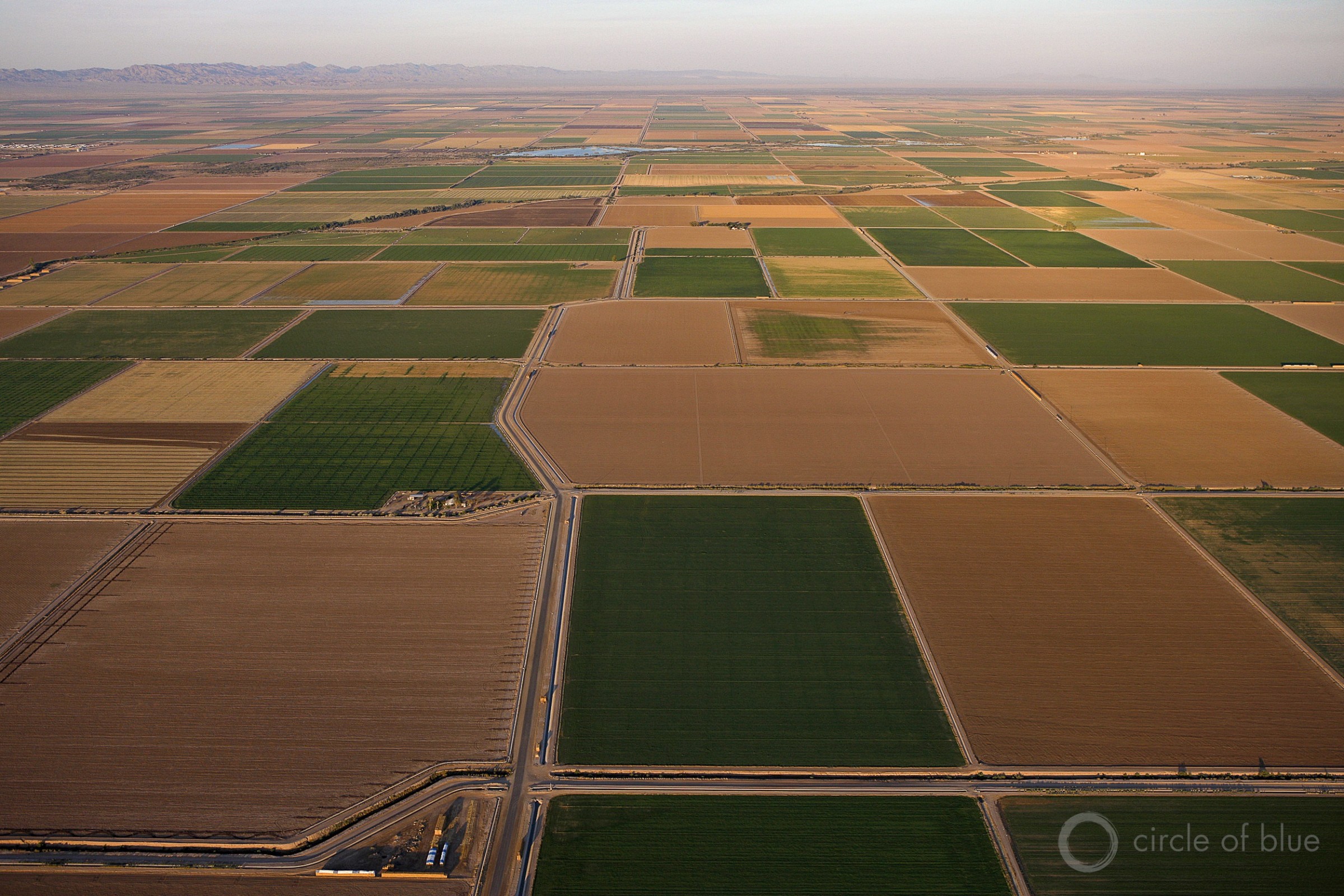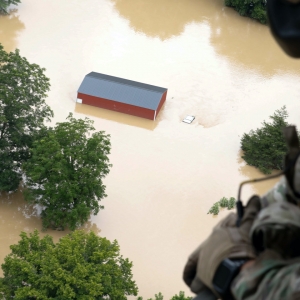Nearly 1 million acre-feet of compensated water cuts are being discussed.

Farm fields resemble a mosaic in California’s Imperial Valley. The Imperial Irrigation District holds more rights to Colorado River water than any other user in the basin. Photo © Brent Stirton/Reportage by Getty Images for Circle of Blue
By Brett Walton, Circle of Blue – August 4, 2022
- A plan is circulating among irrigation districts in southern Arizona and California to reduce Colorado River use by as much as 925,000 acre-feet.
- Such a plan would require billions in funding.
- These discussions foreshadow difficult negotiations in the coming years to balance water demand with a declining supply.
Knowing they are targets, farmers in southern Arizona and California who receive irrigation water from the Colorado River are discussing a plan that could go a long way toward meeting a federal conservation mandate in the drying basin.
With key reservoirs Mead and Powell at record lows and despite the continued decline of the Salton Sea, federal officials are demanding historic cuts in water use next year, on the order of 2 million to 4 million acre-feet, or roughly one-third of the river’s recent annual flow.
Irrigation districts in Arizona’s Yuma County and California’s Imperial and Riverside counties control more of the river’s water than any other entity in the basin. The Colorado River Indian Tribes, whose reservation abuts the river, also hold significant secure water rights.
A plan is now circulating among those districts to forgo 1 acre-foot of water per irrigated acre next year. In the Yuma area that amounts to a 20 percent cut, according to Tom Davis, manager of the Yuma County Water Users’ Association.
The emergency actions foreshadow difficult negotiations that will take place in the coming years as a river that irrigates 5 million acres and supplies 40 million people with a portion of their drinking water is decimated by a drying climate. Agriculture consumes about 80 percent of the basin’s water, making it a cornerstone for bringing demand in line with supply.
The discussions today could set the tone. As many as 925,000 acre-feet could be part of the current deal, about half or a quarter of the total cuts the federal government is seeking.
The forgone water would remain in Lake Mead, which is at its lowest level since 1937, when the big reservoir was being filled. Federal officials want to prevent a catastrophic outcome: the reservoir dropping so low that it can no longer generate hydropower or deliver water downstream.
Irrigation districts are willing to contribute — as long as they are paid.
“If agriculture steps up and makes it possible for the river to survive, they are taking a huge risk for their industry,” said Wade Noble, coordinator of the Yuma County Agriculture Water Coalition, which represents farmers in southwest Arizona. “And that risk and the cost analysis that goes into it is going to require some sort of compensation because they have a water right.”
The dollars at play could be significant. A range of values are being discussed, but a center point is $1,500 per acre-foot. If all 925,000 acres participated in the program, the total cost would be $1.4 billion a year.
It is unclear at this point how many irrigation districts are on board. Camille Touton, the commissioner of the Bureau of Reclamation, told the states to present a plan by mid-August. But observers in the basin do not consider that a firm deadline. Davis cited the accelerated timeline and delicate nature of the negotiations.
Noble outlined the agriculture conservation plan at the July 13 meeting of the Arizona Reconsultation Committee, a group that is advising the state government on Colorado River negotiations. He suggested a four-year program with a total cost between $4 billion and $8 billion.
“As we look at the risk to economies,” Noble added. “As we look at the risk to other industries. As we look at the risk to our urban areas, we don’t believe that you can say that is too much money.”
Noble did not return multiple phone messages seeking comment.
Robert Glennon, a water law and policy expert and professor emeritus at the University of Arizona said that though the dollar figures may seem high at first glance, they are miniscule compared with the risks involved.
“Why should that be a deal breaker?” Glennon asked about a nearly $2 billion annual price tag. “I mean, it’s only a one-year deal. But it’s wet water that saves everyone’s bacon while you’re trying to develop some long-term criteria.”

Bell peppers are one of roughly a hundred crops grown in Imperial Irrigation District. Photo © J. Carl Ganter/Circle of Blue
These irrigated areas are among the harshest climates in the United States, arid lowland regions of the Sonoran Desert that receive no more than 4 inches of rain in an average year.
The Colorado River is the ingredient that turned these drylands green. Applying more than 5 feet of water per acre of land each year allows farmers in Imperial Irrigation District, Wellton-Mohawk Irrigation District, Palo Verde Irrigation District, and a half dozen others to produce a staggering bounty of vegetables, grains, forage, and seed crops. Growing more than 100 crops, these counties are among the richest farming regions in the country, each generating more than $1 billion in sales in 2021.
The steady flow of the Colorado is the fuel that powers the ag machine. The threat that the spigot will be turned off has brought the irrigation districts to the table.
If dividing the river during a period of shortage were based purely on the law, then the irrigation districts would not have to worry. They hold some of the most legally ironclad rights to the river, those that are last in line for cuts.
Imperial Irrigation District, the largest of the bunch, has claim to 2.6 million acre-feet for irrigation, nearly as much water from the Colorado River as the entire state of Arizona. That water nurtures about 470,000 acres of alfalfa, Bermuda grass, Sudan grass, sugar beets, onions, lettuce, and other crops. Secured by a U.S. Supreme Court decree, Imperial’s water rights would be the last to be touched.
The political reality, however, is altogether different, according to Michael Pearce, an attorney with Gammage and Burnham who has more than three decades of experience in Arizona water law and policy.
“In a practical sense, you can’t see the cities of Phoenix and Los Angeles, and even Las Vegas and some of the cities on the Colorado River — Bullhead City, Lake Havasu City — have their water supply cut off so that you can grow alfalfa in Yuma and in the Imperial Valley,” Pearce told Circle of Blue. “This cannot be a practical solution.”
The Central Arizona Project, the 336-mile canal that supplies Phoenix and Tucson, has junior water rights to the Colorado River. But Arizona’s water leaders have publicly stated that they will not sign any agreement that allows the canal to run dry.
Leaders in the four upper basin states of Colorado, New Mexico, Utah, and Wyoming are also looking downstream for solutions. In a July 18 letter they argued that the burden of the conservation mandate should be placed on Arizona, California, and Mexico, which together use more than double the water than the upper basin. Besides the irrigation districts, urban suppliers in the basin are also putting forward conservation plans.
Another factor in the irrigation districts’ willingness to come to the table is that the mechanics of water delivery will eventually triumph over the law. Even the most secure legal rights are worthless if Mead sits at dead pool and no water can pass downstream.
How might the farmers be paid off? Glennon and Pearce noted a number of options. Congress could appropriate money. A wildfire and drought response bill that the House passed at the end of July authorizes $500 million to prevent Mead and Powell from declining to unacceptable levels. Or the White House could declare a federal disaster. Any outcome, they said, would likely require states to contribute funds.
Those are potential short-term actions. In the long run, the current water rights arrangement is untenable, Glennon said. The drying basin has a structural deficit — more promises of water than physical water to distribute. The states, tribes, and federal government will have to not only rebalance water supply and demand, but also address the shrinking Salton Sea.
“That conversation has to take place,” Glennon said.
Located north of Imperial Irrigation District, the Salton Sea is an agricultural sump, a desert depression that receives most of its water from farm runoff. Less irrigation means less water flowing into the sea. A receding shoreline exposes more seabed salts and chemicals to winds. The area has some of the nation’s worst air quality.
Whether a system established more than a century ago that privileges desert agriculture is compatible with a hotter, drier, ecologically imperiled, urbanized 21st century is a question that will take years to resolve — but with little time to waste.
Brett writes about agriculture, energy, infrastructure, and the politics and economics of water in the United States. He also writes the Federal Water Tap, Circle of Blue’s weekly digest of U.S. government water news. He is the winner of two Society of Environmental Journalists reporting awards, one of the top honors in American environmental journalism: first place for explanatory reporting for a series on septic system pollution in the United States(2016) and third place for beat reporting in a small market (2014). He received the Sierra Club’s Distinguished Service Award in 2018. Brett lives in Seattle, where he hikes the mountains and bakes pies. Contact Brett Walton




